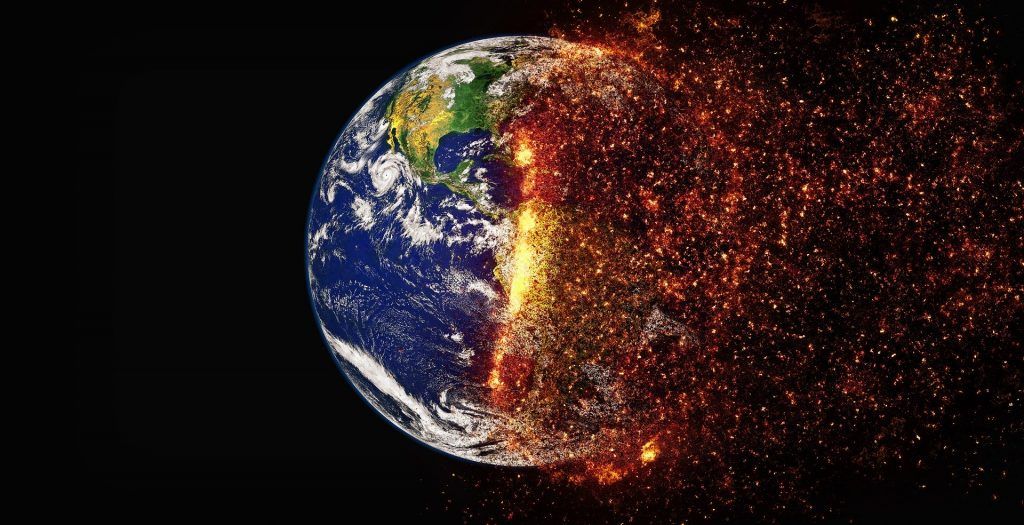Best path to net zero: Cut short-lived super-pollutants
By Mario Molina, Veerabhadran Ramanathan, Durwood J. Zaelke | April 2, 2020
 Image courtesy of Pixabay
Image courtesy of Pixabay
The drive to achieve net zero climate emissions by 2050 continues to gain momentum. Last September, the UN secretary general reported that more than 60 countries have committed to the goal of reducing their individual net emissions of greenhouse gases to zero, or “net-zero” carbon emissions, by 2050 or earlier—at least in the energy sector.
And countries aren’t the only ones making this commitment; many cities, businesses, provinces, and US states have joined in—including some states with economies so big that they rival those of nations. (These so-called “subnational economies” play a vital role in curbing emissions, due to their outsized effect on the playing field; for example, if California was an independent country it would be the sixth-largest economy on the planet, larger than that of France, says the World Economic Forum.) Even two oil companies have made 2050 net zero pledges—although it should be noted that some researchers question the credibility of their plans for carbon reduction.
At first glance, taken overall, these trends generally sound promising. But the climate battle could be lost long before 2050; it might even be lost by 2035.
Consequently, it is time for fast climate mitigation, especially in the form of reductions of the short-lived so-called “super-pollutants”—black carbon, methane, tropospheric ozone, and hydrofluorocarbons, abbreviated as HFCs. (Black carbon is the sooty, dark material emitted by coal-fired power plants, gas and diesel engines, and other sources. Its heat-trapping power is twice what was thought only a few years ago, a report in the Journal of Geophysical Research found.) Speed must become the key measure of all climate mitigation strategies: a speedy reduction of global warming before it leads to further, self-reinforcing climate change feedbacks and tipping points; a speedy deployment of mitigation actions and technologies; and getting this all up to scale in a speedy manner.
And let us be clear: By “speed,” we mean measures—including regulatory ones—that can begin within two-to-three years, be substantially implemented in five-to-10 years, and produce a climate response within the next decade or two.
For as the Intergovernmental Panel on Climate Change IPCC 1.5°C Special Report highlights, cutting these super-pollutants (along with reductions of carbon dioxide, of course) is essential to limit warming to 1.5 degrees Celsius above preindustrial temperatures.
The feedback problem. Rapid warming over the near term threatens to accelerate self-reinforcing feedbacks in which the planet starts to warm itself in a Hothouse Earth scenario—vicious cycles which could lead to uncontrollable warming as these feedback mechanisms become the dominant force regulating the climate system. These feedbacks would then set off a domino-like cascade that triggers tipping points in the Arctic and elsewhere, many of them irreversible and potentially catastrophic.
The vulnerability of the Arctic demonstrates the immediate challenge. Already, the extent of Arctic summer sea ice has been reduced by 40 percent from 1979 to 2011. Within a decade or two, the Arctic could become largely ice-free in summer and lose the rest of its heat-reflecting shield entirely. The complete disappearance of the Arctic’s sea ice over the summer months would add the equivalent of 1 trillion tons of carbon dioxide to the atmosphere—more than a third of the 2.4 trillion tons emitted in the 270 years since the dawn of the Industrial Revolution. This would put the 1.5 degrees Celsius target out of reach, and set us up to crash through the even worse level of 2 degrees Celsius—25 years faster than currently expected.
The heating produced by the loss of Arctic summer sea ice also threatens to set off a second feedback loop, by further accelerating the thawing of the permafrost in northern lands, releasing their ancient stores of carbon dioxide, methane, and nitrous oxide, causing still more warming. The latest evidence shows that large emissions of carbon dioxide and nitrous oxide are already occurring from the melting of northern permafrost, even in the winter months.
There also is the risk that as the Arctic ocean warms, more methane could be emitted from the shallow seabed of the East Siberian Arctic Shelf, which in turn would speed up other global warming effects. If a large pulse of methane were to be emitted from the East Siberian Arctic Shelf this decade, then up to 0.6 degrees Celsius of additional warming could be added by 2040—advancing the danger of hitting the 2 degrees Celsius mark by 15-to-35 years. While this currently appears unlikely, it would be costly if it occurred; just the release of methane from the thawing permafrost beneath the East Siberian Sea, off northern Russia, would carry an estimated price tag of $60 trillion in terms of global remediation, adaptation, and resiliency, according to a 2013 study published in Nature.
Other feedbacks and tipping points include the die-off of the Amazon forest—now a critical “sink” for removing and storing carbon dioxide—and the slow-down of the warm Atlantic current often known as the Gulf Stream, as well as the acidification of the ocean and the extinction of many species of flora and fauna. Many of these tipping points may be just around the corner. Even more await us if we crash through that 1.5 degrees Celsius guardrail.
The need for speed. Time is of the essence for slowing these feedbacks: The planet is currently on course to add 50 percent more warming and exceed the 1.5 degrees Celsius threshold for dangerous warming as early as 2030, with a one-in-10 chance of doing so a full five years earlier, or 2025. As warming continues to accelerate, weather extremes are expected to worsen, imposing more serious impacts on ecosystems and public health. Already, in the 20 years prior to 2015, weather-related disasters have killed 30,000 people a year on average—more than 600,000 in total—while leaving more than four billion people injured, homeless, or in need of emergency assistance.
The window for limiting these threats has shrunk to perhaps 10 years, according to a recent Comment piece in Nature aptly titled “Global warming will happen faster than we think.” Whatever pathway we select to reach the goal of net zero must harvest all the low-hanging fruit of mitigation opportunities over the next decade; that way, we stand a chance of slowing climate change enough in the near-term to stay in the game and possibly win by 2050.
The harvesting should start with immediate cuts to the emissions of short-lived super-pollutants—black carbon, methane, tropospheric ozone, and HFCs. As a net-zero carbon dioxide strategy, fast cuts to super-pollutants would halve global warming by 2050, cut the rate of warming in the Arctic by up to two-thirds, and at least halve the amount of warming over elevated regions of the Himalayas and Tibet. This would avoid up to 0.6 degrees Celsius of global warming by 2050, and provide life-saving collateral benefits along the way. (And, of course, we need to continue our efforts to simultaneously cut carbon dioxide emissions and protect our carbon sinks. But we should be able to walk and chew gum at the same time.)
Cutting the short-lived super-pollutants can be done. The Paris-based Climate and Clean Air Coalition to Reduce Short-lived Climate Pollutants (CCAC) calculates that: “[a]bsolute reduction targets of at least 45 percent reduction in methane emissions by 2025, and 60-to-75 percent by 2030 … are realistic and achievable targets, especially in a sector where technology and financing are largely available… .”
We already have in place a structure to rein in super-pollutants: the Kigali Amendment to the Montreal Protocol, which mandates the phasedown of super-pollutants like HFCs, which in itself could avoid up to 0.5 degrees Celsius of warming by the year 2100. We simply need to add these other super-pollutants to the existing framework. As it is, the initial phasedown schedule of the amendment avoids about 90 percent of the potential surface temperature changes due to HFCs, while parallel efforts to improve the efficiency of cooling equipment could more than double the climate benefits by 2050. Meanwhile, California has already eliminated 90 percent of its black carbon emissions, providing a model for other jurisdictions.
Many countries have already included some short-lived climate pollutants in their nationally determined contributions to climate mitigation under the Paris Agreement. Over 90 percent of countries are pledging to reduce their methane emissions, and over half to reduce their emissions of HFCs.
Of course, in addition to cutting super-pollutants, other things could help us achieve fast mitigation—such as halting deforestation so that existing forests can grow to their full ecological potential as carbon sinks. Similarly, improved land management could increase carbon storage or avoid greenhouse gas emissions; together they may be able to provide more than a third of the cost-effective carbon dioxide mitigation needed through 2030 to give us a reasonable chance of limiting warming to less than 2 degrees Celsius.
But whatever the final mix of strategies, nations must quickly commit to a clear near-term pathway to strengthen the 2050 net zero target and enshrine the need for speed as a key goal for all mitigation. This would stimulate the urgent action required to win both the 2050 battle—and the immediate challenge of slowing the feedbacks and tipping points that will otherwise defeat us well before we get to mid-century.
Failure to solve the problem of super-pollutants along the pathway to a world of net-zero carbon emissions risks catastrophic and perhaps existential impacts from a Hothouse Earth—risks the planet is woefully unprepared to meet at the present time.
Together, we make the world safer.
The Bulletin elevates expert voices above the noise. But as an independent nonprofit organization, our operations depend on the support of readers like you. Help us continue to deliver quality journalism that holds leaders accountable. Your support of our work at any level is important. In return, we promise our coverage will be understandable, influential, vigilant, solution-oriented, and fair-minded. Together we can make a difference.
Keywords: Carbon emissions, HFCs, black carbon, climate change, climate crisis, global warming, methane, super-pollutants
Topics: Climate Change

















This vital argument was elaborated 2 Dec 2019 in the last section of “Recalibrating Climate Prospects” at https://doi.org/10.1088/1748-9326/ab55ab. We suggested that if any major oil company or service company chose to shift from compliance to entrepreneurial mentality and from just its own assets to global assets, it could go far toward a global rollup of the profitable opportunity to abate flares and engineered vents. These dominate upstream hydrocarbon-industry emissions and could almost certainly stabilize the global methane cycle. And why stop there? Overperformance could even shrink methane concentrations. Either way, it’s the fastest way we know to turn down the… Read more »
Dear Sirs, To fight global warming, have the United nations create ‘ The global 50/50 Lottery’ to raise the massive funds needed to purchase clean electricity generating systems everywhere in the world, to replace the electricity from our coal burning electric power plants, which are emitting the carbon dioxide that is causing global warming. Remember, human greed is like a force of nature that can move mountains. If we can exploit it to fight global warming, we can beat it!